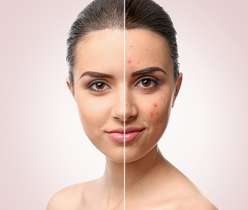Melasma is a common skin condition caused by brown to gray-brown patches on the facial skin. Most people develop on their forehead, cheeks, nose bridge, and above the upper lip area. It is more common in women than men. Pregnancy is a common cause of melasma diagnosis. It also affects women taking contraceptive pills and hormones.
Symptoms
Melamsa symptoms appear as discolored patches. These skin patches usually appear darker than your usual skin color. It typically affects facial skin and is symmetrical, with matching marks on both sides of the face. Other skin areas of your body often exposed to the sun can also develop melasma. Brown patches occur on the forehead, cheeks, chin, and nose bridge.
Causes
What causes melasma? Factors that usually cause melasma include ultraviolet radiation, genetic influences, hormonal therapies, phototoxic drugs, cosmetics, and antiseizure medicines. Melasma is a skin condition that causes melanocytes by the female sex hormones, including estrogen and progesterone, releasing more melanin pigments when the skin is exposed to ultraviolet to the sun.
-
- Genetic
Genetics plays a crucial role in the occurrence of melasma. Melasma skin is more commonly reported in females than in males. Individuals with light brown skin types from regions of the world with excessive sun exposure are prone to the development of melasma. Around 50% report a positive family history of the condition.
-
- Exposure to sunlight
UV radiation can bring free radicals that could stimulate melanocytes to produce excess melanin.
-
- Hormonal disturbances
Hormones play a significant role in some individuals. The mask of pregnancy is known to occur in obstetric patients. The exact mode of action is still not known. The estrogen, progesterone, and melanocyte-stimulating hormone levels normally increase during the third trimester of pregnancy, which may be a factor. A female who is postmenopausal and given progesterone may develop melasma, while those who are provided estrogen alone do not. This shows that the progesterone hormone plays a primary role in the development of melasma.
-
- Thyroid disorder
There is an increase in thyroid disorders in melasma patients. This causes melasma spots to increase all over the facial skin.
Treatment
The best treatment for melasma on face is a topical combination of hydroquinone cream and avoiding sun and estrogen exposure. In addition to avoiding sun exposure, use SPF formulation to prevent the development of melasma. First-line melasma treatment consists of effective topical treatments, mainly in the form of triple combinations (tretinoin 0.05%, hydroquinone 4%, and fluocinolone acetonide 0.01%) and when triple combinations are unavailable or when patients have hypersensitivity to them they may be prescribed with other formulations. Patients can check before and after melasma pictures of those who used this triple combination therapy. A dual combination or single agents should be considered for melasma forehead. Consult your doctor to learn the right medicines to treat melasma safely.
Chemical peels and lasers may produce unpredictable results and are associated with side effects, including post-inflammatory hyperpigmentation and hypertrophic scars. These interventions come under the second-line melasma treatments and are used only if the topical medicine has failed. Usually, chemical peels and lasers are safe and may produce results faster than topical medications.
Skin peels: These skin procedures have a high risk of side effects. Peels use salicylic acid and glycolic acid-based compounds, which may increase the turnover of hyperpigmented skin cells. The procedure often begins as a monthly treatment using low-concentration formulas and gradually every week at higher concentrations. Lightening agents are usually combined with superficial peels to reduce melasma moustache. After trying this therapy with at least one skin-lightening agent, skin peels should only be utilized. During the procedure, close monitoring of skin pigmentation is required. And in case changes in the pigmentation in the surrounding skin are noted, therapy should be halted.
Lasers
The effectiveness of pico laser for melasma treatment has been associated with undesired cosmetic results. The treatment option should be considered in cases of extensive disease that is refractory to laser use, and it may cause worsening of the condition.
Those dealing with melasma on face should avoid cosmetics on sensitive skin. Vigorously rubbing the triple combination formulation on hyperpigmented areas may worsen the condition.
Melasma supplements
Melasma on upper lip or the whole face can be challenging to manage. Along with topical treatments, one may need to add the right vitamins to his/her diet to unlock the key to clearer, more even-toned skin. Zinc supplements for melasma are particularly beneficial for managing melasma. Buy melasma supplement online at discounted prices. It is always best to consult a nutritionist who can help you find the best oral vitamins for melasma.
Enhancing patient outcomes
Melasma is a benign skin disease that has no morbidity. The main reason why some patients seek medical treatment is aesthetic. The good news is that, in most cases, melasma resolves independently. Thus, patients should avoid the sun and discontinue the medications that trigger this skin condition. There are several treatments for melasma, so choose the one that best suits you. Some treatments, like the laser, may worsen the condition. Patients who haven’t undergone any treatment and avoid the sun will observe that the rash usually disappears in a few months. Ochronosis (appearance of gray-blue or blue-black pigmentation with prolonged exposure to creams with potent steroids.
To avoid side effects, the patient should include strict sun avoidance as this is important for resolution and may prevent the recurrence of melasma. Patients suffering from melasma should apply bleaching creams to dark areas only. Strict sun avoidance measures and regular use of topical bleaching creams can take many months. Patients can expect slow but gradual lightening.




